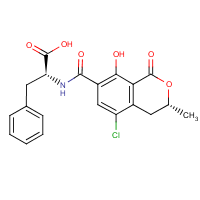Ochratoxin A
Agent Name
Ochratoxin A
CAS Number
303-47-9
Formula
C20-H18-Cl-N-O6
Major Category
Biological Agents

Synonyms
(-)-N-((5-Chloro-8-hydroxy-3-methyl-1-oxo-7-isochromanyl)carbonyl)-3-phenylalanine; (R)-N-((5-Chloro-3,4-dihydro-8-hydroxy-3-methyl-1-oxo-1 H-2-benzopyran-7-yl)carbonyl)phenylalanine; Alanine, N-((5-chloro-8-hydroxy-3-methyl-1-oxo-7-isochromanyl)carbonyl)-3-phenyl-, (-)-; Antibiotic 9663; L-Phenylalanine, N-((5-chloro-3,4-dihydro-8-hydroxy-3-methyl-1-oxo-1H-2-benzopyran-7-yl)carbonyl)-, (R)-; N-(((3R)-5-Chloro-8-hydroxy-3-methyl-1-oxo-7-isochromanyl)carbonyl)-3-phenyl-L-alanine; Phenylalanine - ochratoxin A; [ChemIDplus] UN3462
Category
Mycotoxins
Description
Solid with a green fluorescence; [Merck Index] Faintly yellow powder; [MSDSonline]
Sources/Uses
Used as a research chemical; [HSDB] A toxic metabolite of Aspergillus ochraceus, Aspergillus sulphureus, Aspergillus melleus, and Penicillium viridicatum molds. Ochratoxins have been found as natural contaminants on corn, peanuts, storage grains, cottonseed, and other decaying vegetables; [Merck Index] Human exposure occurs primarily by ingestion of contaminated grain and pork products; [IARC] Produced by Penicillium verrucosum, a common contaminant of barley; [Reference #2]
Comments
May be fatal by ingestion or inhalation; [CAMEO] May cause irritation; Causes injury to the kidneys and liver in high-dose animal studies; [MSDSonline] Causes renal tubular injury and liver damage in high-dose animal studies; Oral LD50 = 0.2 mg/kg for dogs and 59 mg/kg for mice; High levels in the diet are associated with nephropathy in humans and swine in Balkan countries (Balkan nephropathy); [Hayes, p. 644] Factory workers handling contaminated coffee, cocoa beans, spices, and other foods have elevated ochratoxin serum levels; [Reference #1] MAC-2 (considered to be carcinogenic for man because sufficient data from long-term animal studies or limited evidence from animal studies substantiated by evidence from epidemiological studies indicate that it can make a significant contribution to cancer risk); [MAK]
Reference Link #1
Biomedical References
Exposure Assessment
Vapor Pressure
3.31E-16 mm Hg
Explanatory Notes
The Guide in the Emergency Response Guidebook is for "Toxins, extracted from living sources, solid, n.o.s."
Reference Link #2
Adverse Effects
Hepatotoxin
Hepatoxic (a) from occupational exposure (secondary effect) or (b) in animal studies or in humans after ingestion
Nephrotoxin
Yes
IARC Carcinogen
Possible (2b)
NTP Carcinogen
Anticipated human carcinogen
Diseases, Processes, and Activities Linked to This Agent
Other Information
No other related information on this agent was found.